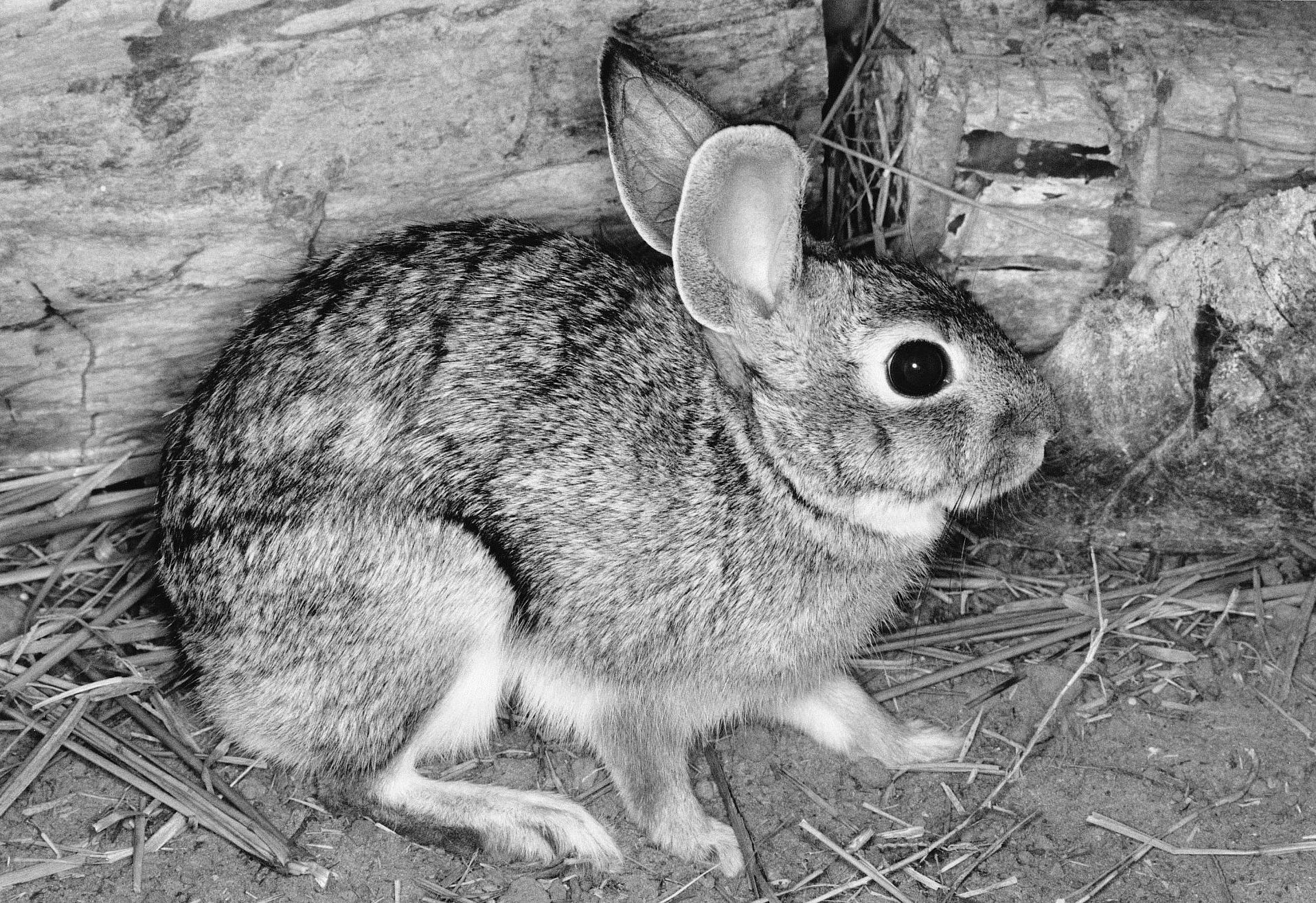DESERT COTTONTAIL
Sylvilagus audubonii (Baird 1858)
Order Lagomorpha : Family Leporidae
DESCRIPTION. Medium-sized cottontail with relatively long ears; pelage rather harsh, but not so harsh as in the swamp rabbit; hind feet relatively slender and with relatively short pelage; auditory bullae large, with rough surface; ratio of length of ear to length of hind foot >0.66; upperparts dark buffy brown, heavily lined with black; rump not conspicuously different from back; top of tail like back; nape bright rusty, almost orange rufous; front and outside of forelegs dark ochraceous buff; hind legs brownish cinnamon; underside of neck brownish buff; rest of underparts and underside of tail clear white. Averages for external measurements: total length, 418 mm; tail, 73 mm; hind foot, 86 mm; ear, 60 mm. Weight, 0.5–1.4 kg.

DISTRIBUTION. Occupies upland habitats in the western half of the state.

SUBSPECIES. Sylvilagus a. minor in the southern Trans-Pecos eastward to Val Verde County, S. a. neomexicanus in the northern part of the range in the state (south to Reeves and northern Brewster counties), and S. a. parvulus from Llano County southward in south-central Texas to the Rio Grande.
HABITS. This species appears to be adapted to a variety of habitats, ranging from grassland to creosote brush and cactus deserts. Wherever it occurs, it frequents brushy areas or, where the vegetation is short, the underground burrows of prairie dogs, skunks, and the like. In the Trans-Pecos region, it is often found in thickets of catclaw acacia, mesquite, allthorn, and other desert shrubs and especially in prairie dog towns in short-grass areas. In the plains regions, it is so commonly associated with prairie dog towns that it is known locally as the prairie-dog rabbit.
Similar to other cottontails, the desert cottontails are more active in the twilight hours and at night, but they may be active through the day. They are more or less sedentary and seldom range >360 m (1,200 ft.) from their preferred thickets, around and in which they feed, sleep, court, and rear their families. Unlike most other cottontails, they are known to climb sloping trees and thick brambles and are not inclined to use beds when resting. Such habits, however, vary from one region to another.
The food is almost entirely vegetation; the kinds eaten vary with availability. In western Texas they eat the leaves and green pods of mesquite, various grasses, forbs, bark and twigs of shrubs, and the juicy pads of prickly pear.
The breeding season is long. In Texas, onset of breeding begins in February, and pregnant females, lactating females, and young in the nest have been found in every month except January, July, and October. There may be more than two litters per year. The number of young per litter varies from one to six, averaging about three. The gestation period is not known, but it is probably about 26–27 days.
As with other cottontails, the young are reared in nests that are made in pear-shaped excavations in the ground, with entrances only about 5 cm in diameter. Below, they are flared out to a width of 15–25 cm; the depth varies from 15 to 25 cm. They are lined with a layer of dried grasses, and the inside is filled entirely with rabbit fur, in which the young sleep and grow. The female lies or squats over the opening to nurse her young, which are blind and hairless at birth. By 10 days of age the eyes have opened, and within another 4 days the young are able to move outside the nest, although they remain near the nest for about 3 weeks. The life span is 2 years or less.
Golden eagles, northern harriers, Swainson's hawks, great horned owls, barn owls, gray foxes, and gopher snakes are known to prey on desert cottontails. Doubtless, many other animals also feed on them.
POPULATION STATUS. Common. The desert cottontail is abundant throughout its range (western third of the state). Where it occurs, desert cottontails can be found in large numbers.
CONSERVATION STATUS. The IUCN status is listed as least concern, and the desert cottontail does not appear on the federal or state lists of concerned species. There is no reason to be concerned about its status at the present time.
From The Mammals of Texas, Seventh Edition by David J. Schmidly and Robert D. Bradley, copyright © 1994, 2004, 2016. Courtesy of the University of Texas Press.
Natural Science Research Laboratory
-
Address
Museum of Texas Tech University, 3301 4th street, Lubbock, TX 79409 -
Phone
806.742.2486 -
Email
nsrl.museum@ttu.edu

